Heaven or hell? The Nürburgring 24 Hours
The Nürburgring 24 Hours remains gloriously old-school in a modern world. Damien Smith returned for a long-overdue visit
Gruppe C Photography
Thank the automotive gods for the Nürburgring. Since its creation in 1927, the rollercoaster through the verdant Eifel forests has been considered the ultimate test, and it still is today. Hence the steady drip of car manufacturer record attempts that keep the Nordschleife regularly in the news. It’s still absolutely relevant. And yet it’s also a strange anachronism in our fast-changing world. Yes, the ’Ring is safer than it used to be, but relative to other old-school hairy race circuits neutered for the modern age, not by much. Better barriers, debris fencing and track surfaces are all very well, but the sheer physicality and pure-bred nature of threading it through the trees without respite until you get to the big straight cannot be diluted. Its throwback character is precisely why the car makers still value it. There’s nowhere else that can match the ’Ring.
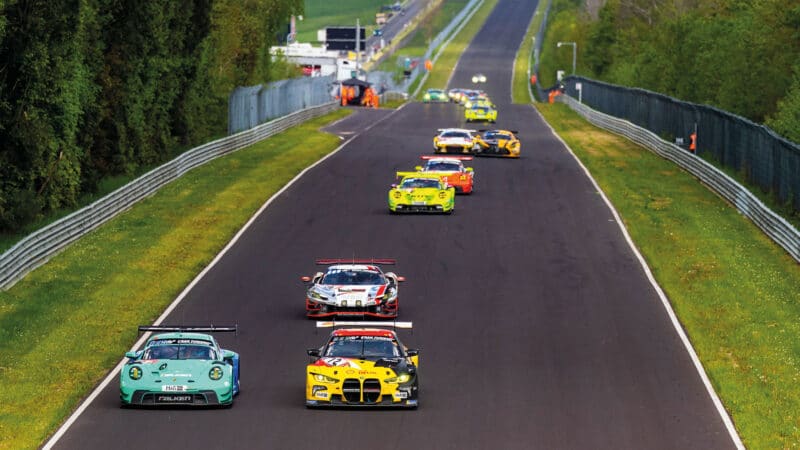
GT3 cars have changed hugely in recent years, and aero developments mean they’re now faster through corners but slower on straights. They’ll now lap at an average above 180kph (112mph)
Gruppe C Photography
Test and development is one thing, but even the Nürburgring would lose some of its lustre without the thrill of racing. The Nürburgring Langstrecken-Serie (NLS), as the name suggests, is a one-track championship (formerly known as the VLN) that keeps alive the competitive flame and spurs drivers to become Nordschleife specialists. Few circuits inspire and support such commitment. And the jewel remains the Nürburgring 24 Hours, held each summer since 1970. It’s Germany’s biggest motor race in more ways than one, especially while Formula 1 continues to snub a nation that used to be considered among its most illustrious hosts. But what really enhances the N24’s status is the weight it carries with the Deutsch Big Four: Audi, BMW, Mercedes and Porsche. All invest heavily in a race that for years amounted to little more than a glorified clubbie. Those days are gone. In an era centred on increasingly rapid and spectacular GT3 cars, the race has joined Le Mans, Daytona and Spa to form a golden quartet of unofficial ‘majors’. The N24 matters, especially for those endurance racers who yearn to win the set.
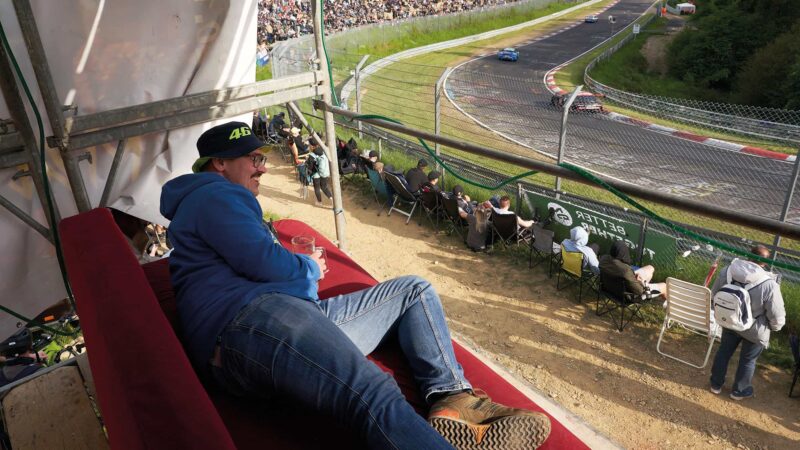
Oddities on and off-track. A fan takes a rest on a sofa perched on a self- built viewing platform
Alamy
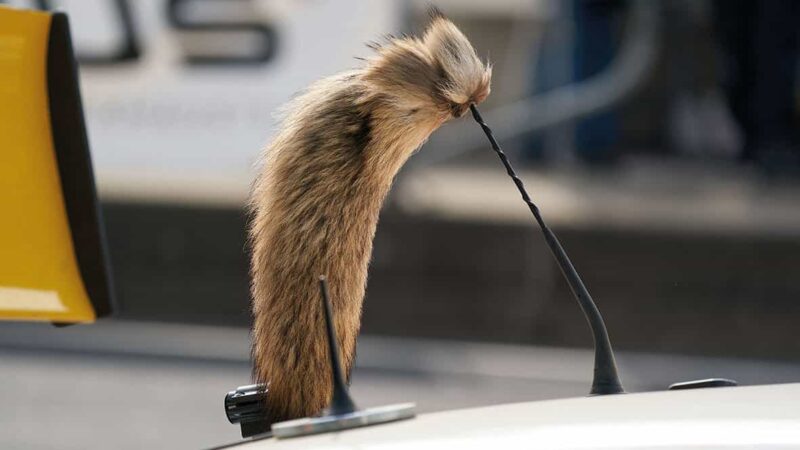
The famous Manta ‘FoxTail’
Alamy
Motor Sport returned to the N24 this May, in an effort to remind ourselves what the Nordschleife still means to modern motor sport, and discover why it still lures our modern-day heroes. It also occurred, once we were out among the lairy campsites in the forests, that we really should make the most of this hardcore race in its current form. If the circuit is an anachronism, the N24 itself is a mind-bending time-warp on a par with the Isle of Man TT. It’s amazing it still exists.
“The 24 Hours here has sun, rain and ice, sometimes all at once”
A road trip is our sole recommendation on getting there. We borrowed a (deep breath) Porsche Panamera 4 E-Hybrid Sport Turismo Platinum Edition for our journey. Yes, we know, a 911 should be preferable, but practicalities count over distance and the squat ‘shooting brake’ has plenty going for it, including a 2894cc V6 mated to a 340kW electric motor for a combined 462bhp. All-electric would have been a brave choice, fraught with recharging jeopardy through Belgium. A 10.30am crossing on the ‘Chunnel’ plus a six-hour journey via the Brussels ring road (rookie error on the route, I can hear our late and much-missed Simon Arron berating me) allowed us to check in at the track by 6pm, just in time for the Friday evening qualifying shoot-out. An 80-litre fuel tank and a range of more than 500 miles meant we didn’t need to trouble the service station pumps until the journey home on Monday morning as the Panamera wafted us with a quiet assurance through three countries to = ‘Green Hell’. By car is the only way to travel to the world’s greatest race track, and the final hour once past Spa, on those sweeping ‘Great Escape’ roads, is the best argument you’ll ever need for European freedom of movement.
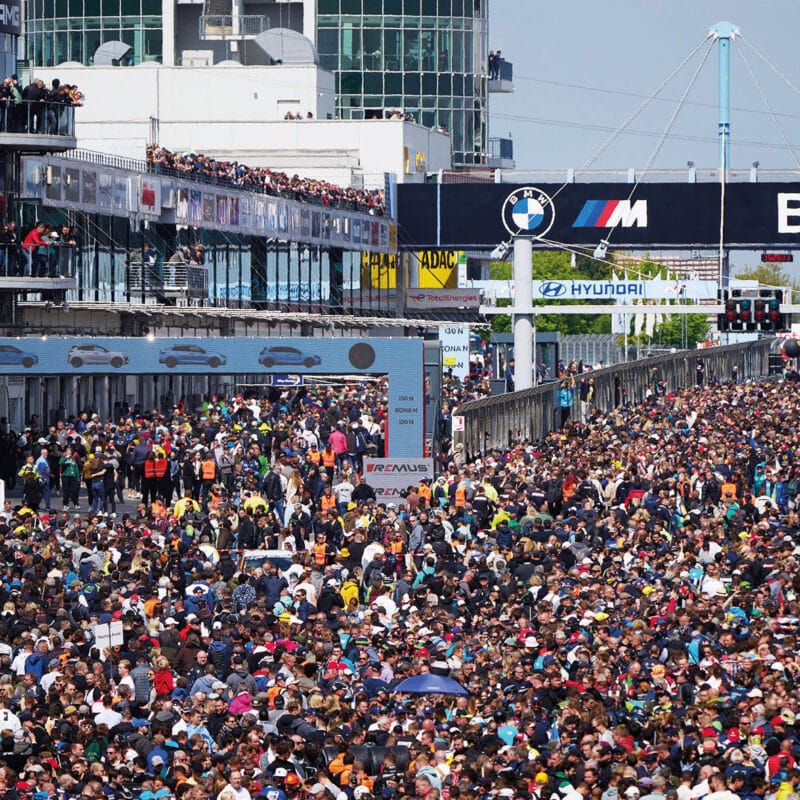
“The 24 Hours here has sun, rain and ice, sometimes all at once”
The race itself remains as mad-cap and chaotic as it was the last time we were here in 2016. The start numbers are down to ‘only’ 131, but while the serious content up front has grown in strength and depth there’s still room for the eccentricities: folk-hero Volker Strycek and his trusty ‘Flying Fox’ Opel Manta, and is that a Dacia Logan? Yes – but it was cruelly punted out during the race. Now the GT3 speeds are up, the competition is tighter and there’s more at stake, negotiating the constant traffic is more critical than ever – while penalties can also shape results. At 15.77 miles including the use of the Grand Prix Circuit, safety cars just don’t work at the Nürburgring, so the zonal Code 60 system has been adopted. Drivers must slow to just 60kph (37mph) through the incident zones and if they break that limit they pay the price. It works brilliantly in terms of keeping the action live, even if drivers grow frustrated at the time lost (especially if the zone limits are lifted when their rivals reach that piece of track). It’s a far preferable alternative to dull and lengthy safety car interruptions – but can catch out even the most experienced crews.
But why do the big brands spend a fortune on this race? Markus Bögner is president and COO of Falken Tyres, a Japanese performance specialist with a big presence in Germany. Such is both the marketing and product development value of this place and this race, Falken has run its own race team at the N24 for the past 20 years. It has invested in a pair of new 992 911 GT3 Rs for the N24 and select NLS races.
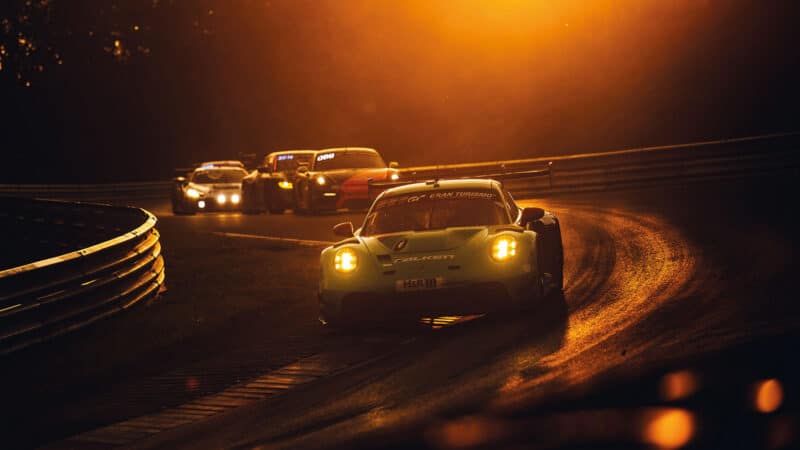
The challenge remains undimmed, perhaps even enhanced, by the increasing performance gaps between cars, and the demanding circuit
“We believe this is our DNA,” says Bögner. “Our slogan for years has been ‘from race track to road’. Also we have customers here, 240 this weekend. We invite them so they understand how big and professional we are.”
So is that race-to-road correlation direct in terms of tyre compounds? It’s not that simple. “You need to think of it like rocket science, like NASA,” he says. “They do a lot of experiments when they go to Mars, then 10 years later you get some product out of these tests. This is how I would compare what we’re doing and why we’re here. You have learning under a circumstance that is completely unique. The 24 Hours here has sun, rain and ice, sometimes all at the same time, and you must be prepared.”
The race is a “big deal” in Germany and Falken enjoys the open competition. Pretty much every major tyre brand is represented, pushing its products to the limit, and beyond. What about the drivers? Why do they still come here? A race of prestige, money… all of that, just as it was for Stirling Moss and Rudi Caracciola. But pleasingly, it’s also the same old core challenge that pulls them back. Austrian Martin Ragginger is Falken’s most experienced Nordschleife specialist, having raced in every N24 since 2008. “The Nürburgring is a fantastic place,” he says. “The adversity you have here is different to all other tracks because we all know the danger – not only our mistake, but the other guys out there. There’s always a risk.”
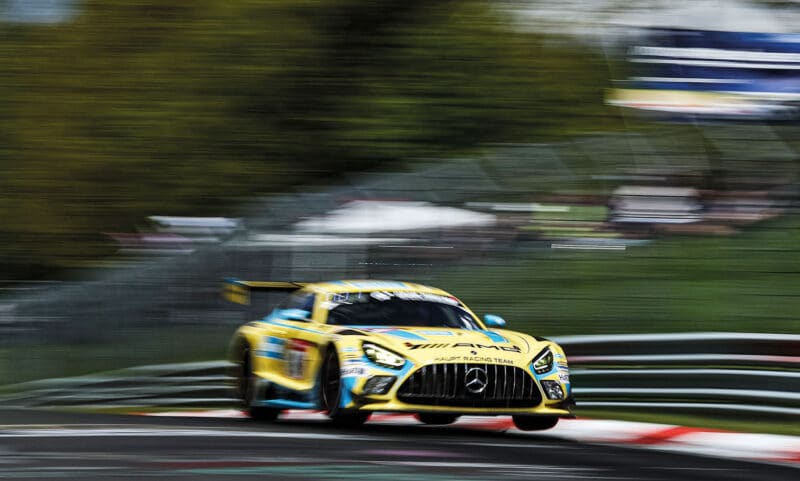
Flugplatz literally translates as Airfield, for good reason.
“Yes, for me traffic is always the biggest factor at this track,” says Belgian Alessio Picariello, who also races a Porsche for Iron Lynx in the World Endurance Championship. “It’s hard because you need to be conservative but you also need to push to stay with the lead, because if you get a Code 60 at the wrong time the gap only gets bigger. It’s basically impossible to come back. You need to find the balance.
“It’s also by far the most physical place I drive. I’ve done Le Mans and it doesn’t come close. Mentally, because you constantly have to predict what the other cars will do, this makes you tired. The only straight is Döttinger Hohe and the rest is corner after corner, and a lot of places are flat out. It takes a lot of energy.”
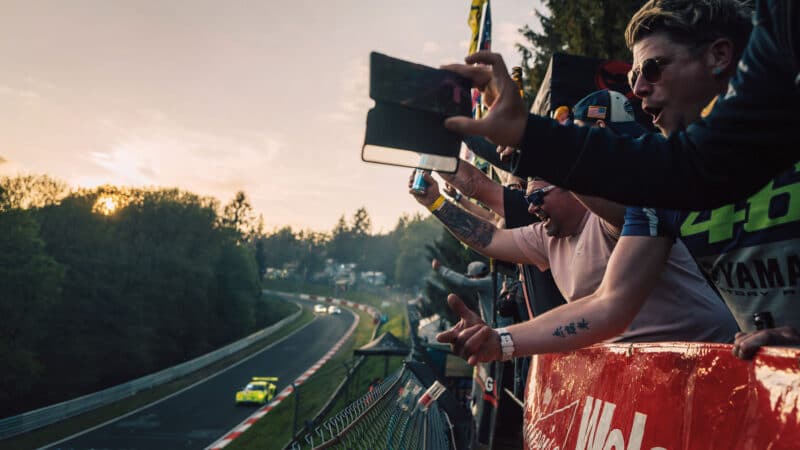
Fans flock to the race each year. Around 230,000 attended this year’s, although it’s impossible to get an accurate figure
Gruppe C Photography
That’s why crews tend to limit their number of stints in the N24. “At Le Mans I can do triple stints without any problems, but here we won’t even try,” says Picariello. “We start with singles to get into a rhythm and then do doubles in the night, then finish with singles again.”
So is it possible to enjoy the racing at the Nürburgring? It just sounds daunting and intense. “I fully enjoy it,” insists Picariello. “It’s the only track I drive where I can feel full-on adrenaline every time.”
The circuit can change year to year through resurfacing, but Ragginger says GT3 gains have made the real difference: “The cars have changed a lot. We used to be faster on the straights, but now we’re faster in the corners.” Again, traffic management is cited as the defining factor. “Also some cars and drivers just come for this one race, and they are not used to this,” adds Sven Müller, a Porsche Supercup champion. “The easiest thing is for them to stay on the racing line and the fast cars will find a way by. But mistakes can happen.”
In the race it is such an incident that puts one of the pre-event favourites out: the green Getspeed Mercedes-AMG driven by the vastly experienced Maro Engel, nerfed off by a wandering Porsche Cayman in the night. “To the amateurs, we respect you and want you in this race,” he wrote in an impassioned plea on social media. “But please stick to your line and don’t change unexpectedly.”
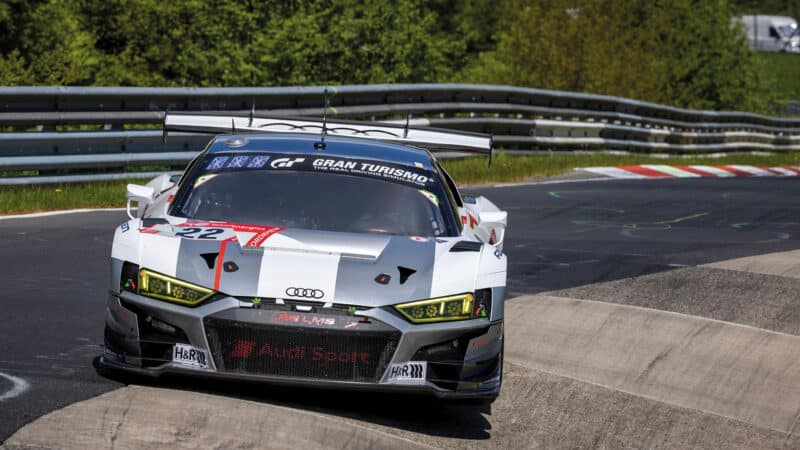
Audi tackles the Karussell
Audi
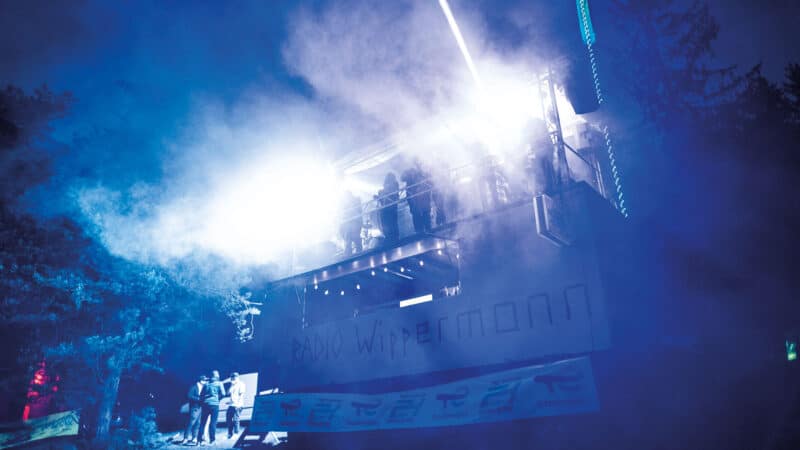
parties thrive in the forests deep into the night
Gruppe C Photography
As for the Falken crews, they too were out of luck, despite one of the turquoise and blue cars qualifying as the fastest Porsche. It ran as high as third in the race, only for contact with a slower car at midnight to send the 911 to the pits for repairs. Tenth at the finish was a disappointing return, but as Bögner accepts that’s the risk of racing – especially when the car is pictured in the final hours circulating slowly with a puncture… The other car faired worse, another victim of the traffic at around 3:30am. The drivers’ pre-race insight into the N24 challenge foretold their own fates. As the clock wound on to 4pm on Sunday, a Brit in a German-run Ferrari wrote a fresh chapter in Nürburgring lore (see sidebar). Aside from Frikadelli Racing’s unbridled joy in victory, our biggest takeaway from the 2023 N24 is just how timeless this event remains, as if it exists in its own private dimension. Out among the estimated 230,000 (mostly drunk) fans in the woods on Saturday night, it seemed that this mammoth event could be taking place in any year from about the mid-1980s onward. All of humanity appears to exist out here – well, that is if you’re white, male and slightly unhinged – as the comically awful club beats pound from 10,000 beer-fuelled BBQs. The Nürburgring at night is life-affirmingly funny, filthy in more than just the literal sense and at times a tad intimidating. It should be experienced – just not for too long.
“The night is life-affirming, funny, filthy and intimidating”
Then there’s the spectacle on track. The speed, the dart of head and tail lights, the full-bore soundtrack that varies incessantly as it reverberates through the trees… it’s magical. And yet all year round, the Deutsch Big Four obsess about legislature and electrification, about net-zero and a future carbon-capture paradise – except here, on this weekend and in this twilight zone that time forgot.
However, times are changing. From next year the N24 will be a counting round of SRO’s Intercontinental GT Challenge – a series where manufacturers compete by nominating their works cars to score points across four different endurance races around the world, with the N24 joining the Bathurst 12 Hours, Spa 24 Hours and Indianapolis 8 Hours. And from next year SRO’s GT3 classes will run on fully sustainable biofuel (made from fermented wine residues, in that most French of ways.)
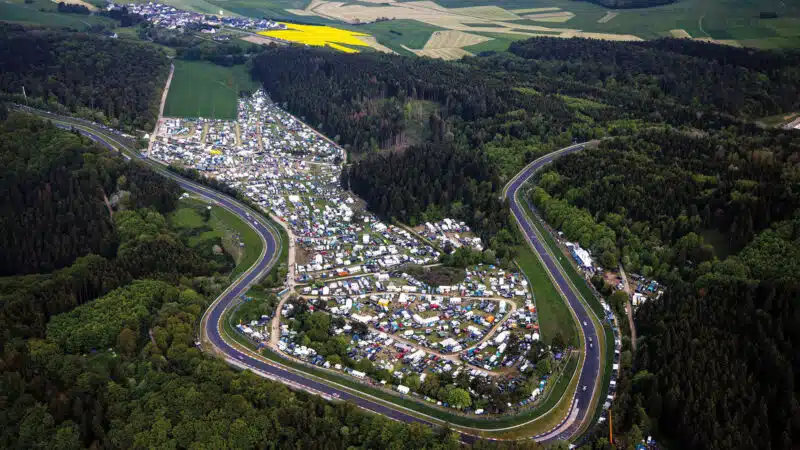
Threading the needle between the trees.
Gruppe C Photography
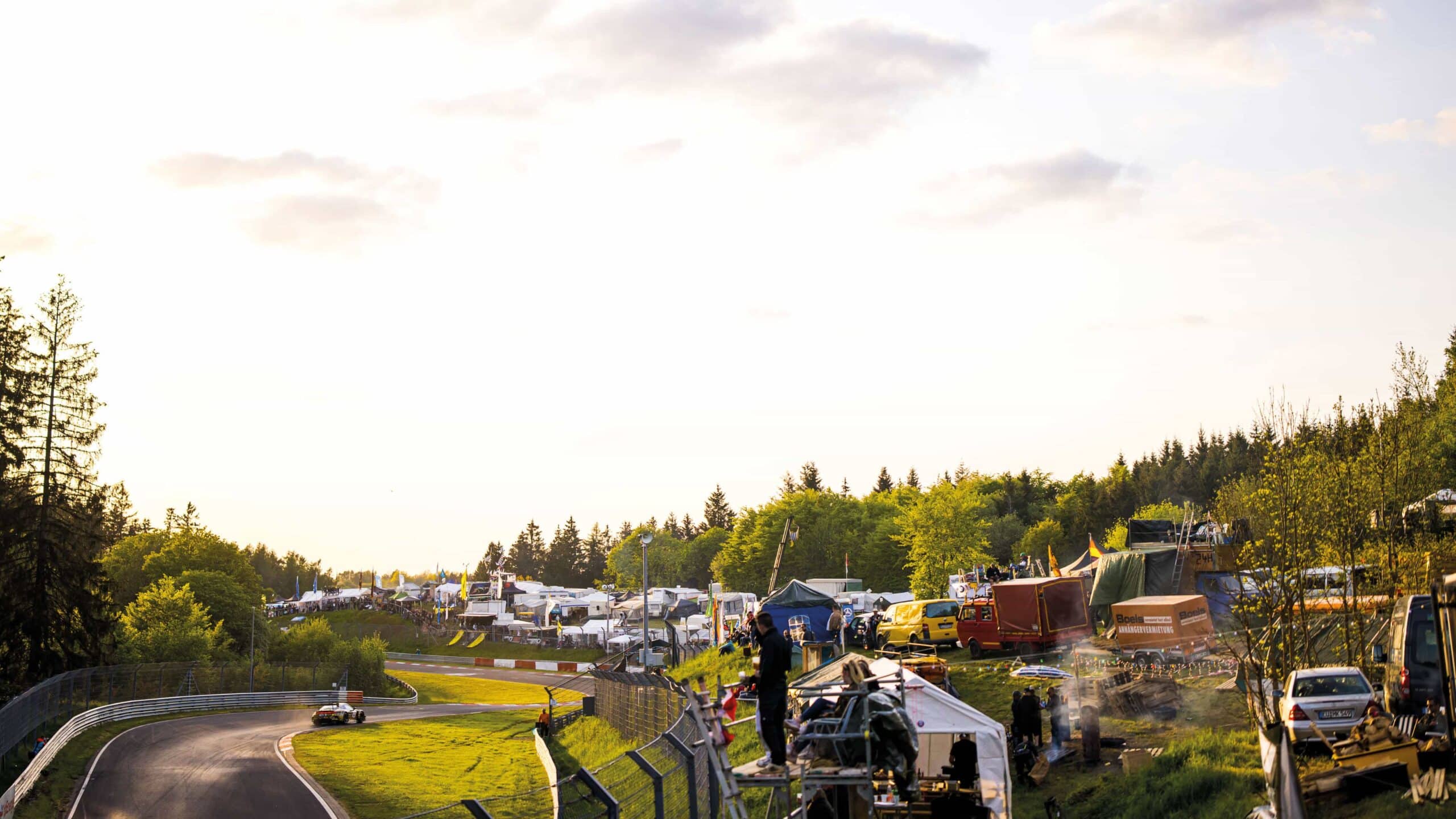
The N24 has experimented with alternative fuels and hybrids for years, but if successful this could be the breakthrough to true sustainability and longevity for large-capacity GT internal combustion engines. Even Bögner admits the race can perhaps continue only “for three to five years” in its current form. Nobody here wants an EV future, but biofuel could well be the solution to keep these cars racing through the trees for years to come.